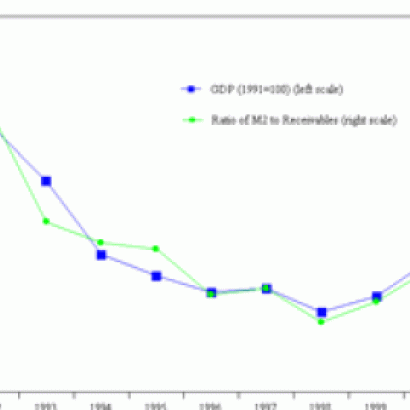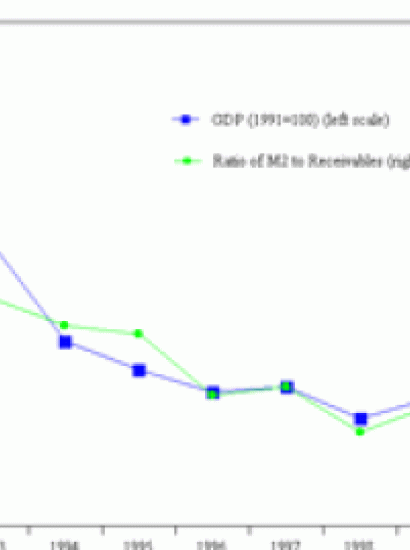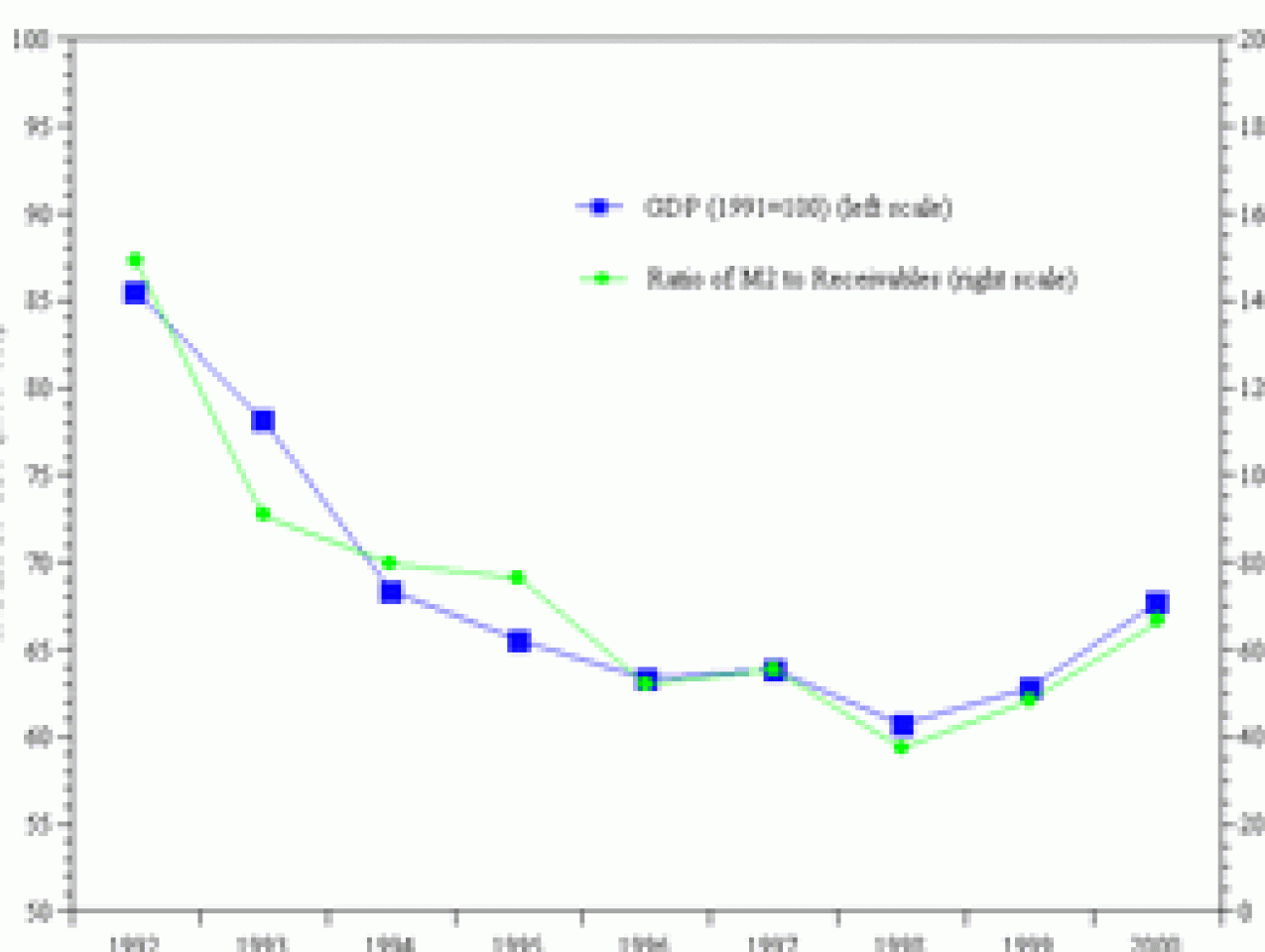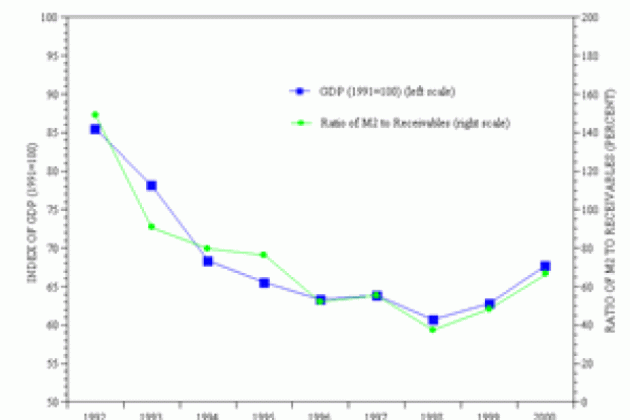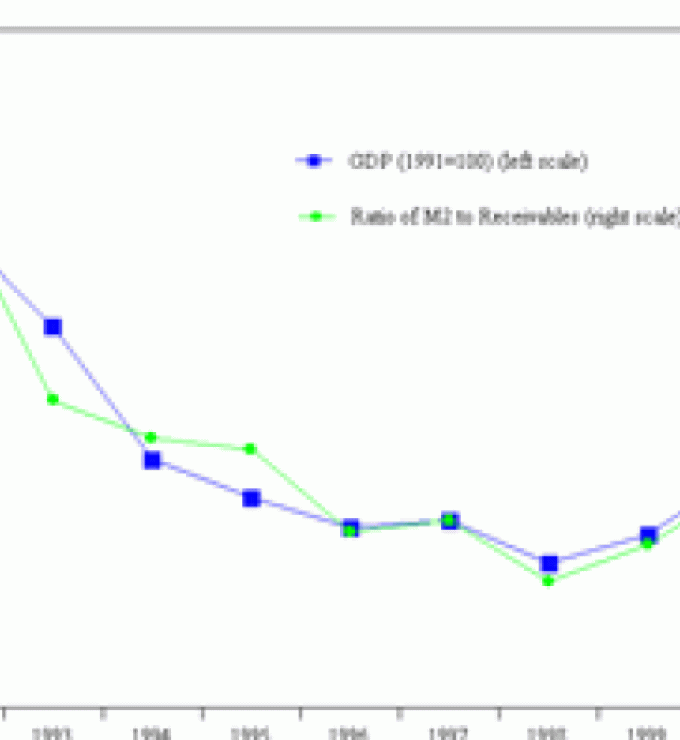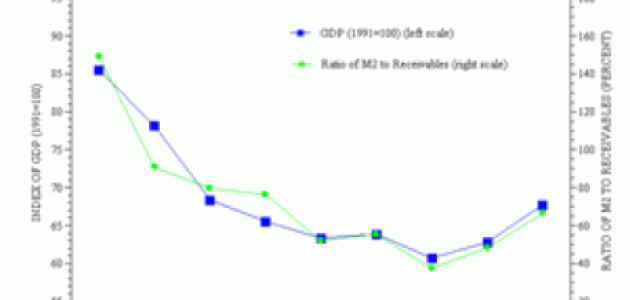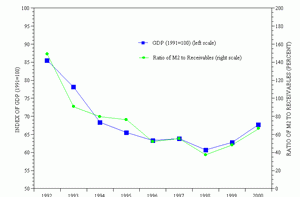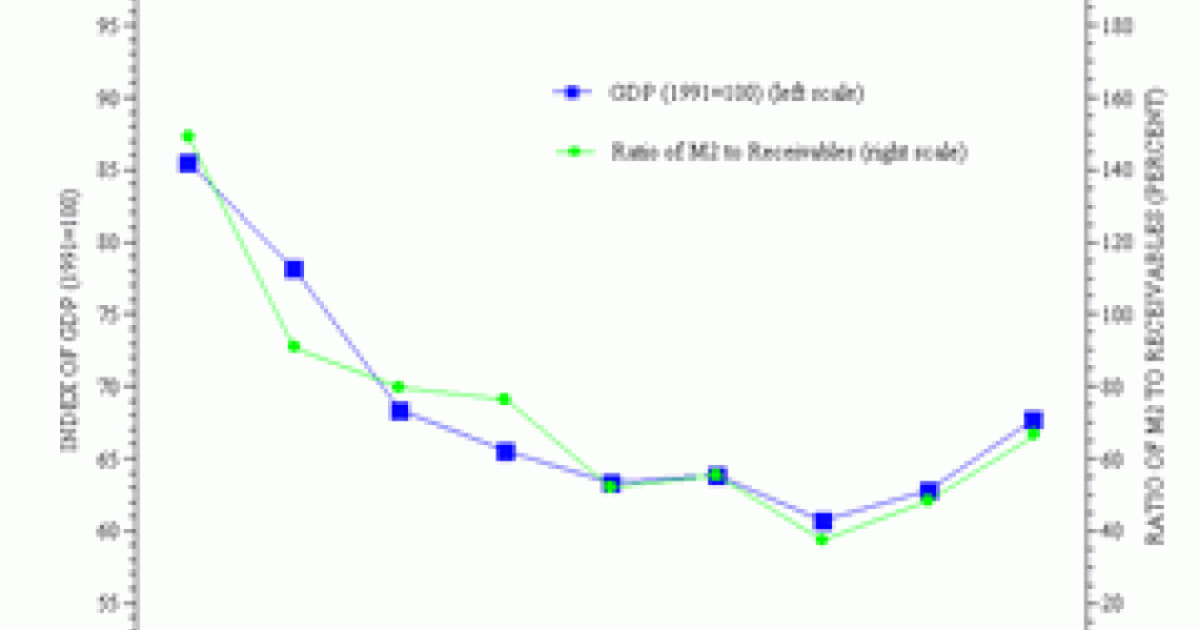Inadvertently, the authors and the readers of this web site have become participants in a scientific experiment. In early 2000, Michael Bernstam and Alvin Rabushka introduced a hypothesis to explain Russia's economic contraction during 1992–98. See Chapter 1 of our book, From Predation to Prosperity, pp. 17–22. We submitted that economic growth or contraction in Russia's economic system are determined by the change in the length of enterprise payments.
The intuition is simple: If it takes 3 months to pay for the bundle of real output (GDP), the existing cash flow buys 4 bundles of output per year. If it takes 4 months, the existing cash flow buys only 3 bundles of the same output per year. In this example, GDP contracts by 25 percent. This accounting truism would hold in any economy, but is irrelevant in most countries where the average length of payments is short (e.g., 28 days in the U.S.) and stable. It becomes relevant when the average length of payments is long and variable:
-
Lengthy payments (arrears) create a payment jam and disrupt the flow of taxes. The government is forced to provide a subsidy to speed up payments. This subsidy (in effect, self subsidy) is embodied in tax non-remittance, in Central Bank credit, and in delegated rents on natural resources. The annual subsidy is equal to incremental receivables. The more arrears, the larger the subsidy.
-
Enterprises manipulate this system to extract the subsidy. They increase or reduce incremental arrears depending on how much subsidy they can enforce. Change in the volume of receivables changes the length of payments. Variable speed of payments affects output, as in the above example.
In the absence of periodic data on the average length of payments, we measured its effect by a proxy: the ratio of the money stock to the stock of receivables. The greater the receivables, the lengthier the payments. We presented annual data for 1992–1999 in figure 2 in Chapter 1 of our book. The fit between the index of GDP and the ratio of the money stock to receivables held year-by-year during 1992–99.
So we said that we have explained the Great Russian Contraction. Meanwhile, the Russian economy reversed to economic growth in 1999. Russian GDP grew at the remarkable rate of 7.7 percent in 2000. If the postulated relationship between the GDP dynamics and length of enterprise arrears has scientific merit, it should hold for growth as well as contraction. Back to the above example. If the average length of payments shortens from 3 to 2.4 months, the existing cash flow can buy 5 instead of 4 bundles of real output. GDP must grow by 25 percent. No mercy to caveats, adjustments, and changes in measurement. Either the hypothesis is confirmed or it is not. The authors and the readers are trapped in an ongoing experiment. It is bound to continue until Russia eradicates enterprise subsidies for payment arrears, which are described in Chapter 1.
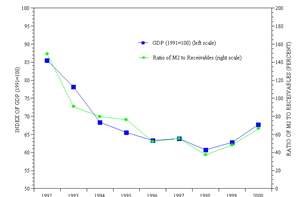
Figure 1 of this article tests the old hypothesis with new data for 2000. It simply extends the old diagram (figure 2 of Chapter 1) to cover the full year 2000. For verification, we append the table with data. We use the latest, slightly revised, official GDP series. The new test exhibits a continuous fit between the index of GDP and the ratio of the money stock to receivables through 2000. The fit is both in the direction and in the relative magnitude (elasticity) of both variables. Through the dramatic swings, downward and upward, over the period of nine years, it establishes an empirical regularity.
A policy reversal of 1998–99
Is the remarkable economic growth in 2000 a fluke? Observers offer various ad hoc explanations (e.g., devaluation, high oil prices, etc.), which are untested or untestable. The IMF admits a surprise and takes an exception:
"In the event, however, improving external earning seeped through to the domestic economy." (1)
They all treat economic growth in 2000 as an isolated episode which has no common denominator with the Great Contraction of 1992–98. This means that no policy lessons can be drawn for long-term growth. Moreover, this growth is said to come at a cost: the year lost for reforms that were not made.
Our analysis links the growth of 1999–2000 to the contraction of 1992–98 in assessing the same underlying factor. It is higher or lower accumulation of enterprise arrears, depending on whether enterprises are free to extract more subsidy or less subsidy. Again, the fiscal working of Enterprise Network Socialism in Russia is described in detail in Chapter 1. What has been different in 1999–2000 that decelerated enterprise arrears and reduced the subsidy? Not a fluke, but a government policy.
This policy has been so much maligned for all the wrong reasons that its real economic effect has escaped notice. In this case, we use the term government broadly. The policy belongs not to the government in the narrow sense of the Cabinet, which has done nothing serious for economic growth; the policy belongs to the Central Bank, which now effectively runs Russian fiscal policy. We explained this unconventional role of the Central Bank in Russia in our article "How Big Are Russia's Foreign Exchange Reserves?"
The Central Bank killed two big birds with one stone when it imposed capital controls in 1998–99: the mandatory repatriation of 50%, then 75% of foreign exchange revenues by Russian exporters. On the face of it, this was not a fiscal policy, let alone growth policy. The Central Bank did not, nor could it, explicitly target fiscal policy and growth policy. It targeted monetary policy, and only a narrow aspect of it: the exchange rate. It also targeted capital flows. The explicit objective was having the right of first refusal in purchasing foreign exchange, with the eye on lending to the government for paying the external debt. But no matter. It is not important what the Central Bank thought or targeted. What matters is the effect. Fiscal, monetary, and external flow policies in Russia function not the same straightforward and compartmentalized ways as is customary in market economies. Under universal income redistribution in Russia, every policy affects subsidies; every policy is fiscal first and foremost. When the Central Bank imposed capital controls, it truncated, indeed guillotined the principal enterprise subsidy in Russia: the subsidy for the accumulation of arrears. This worked through two related channels, one automatic and the other, deliberate choice:
1. When enterprises were forced to repatriate foreign exchange revenues, their revenues became exposed to the tax authority in the cash flow sense. Not just on the books but in the banks. They had to remit more taxes than before. This is because the government could now enforce more tax remittance without endangering the production flow and the tax flow on the part of the cash-starved enterprises. We explained in Chapter 1 how tax non-remittance is the principal component of the enterprise subsidy in Russia and the core of its automatic, self-enforceable mechanism. This subsidy was thus cut and its enforcement mechanism curtailed. Enterprises could expect smaller subsidy as its self-enforcement was constrained. Then enterprises reduced their accumulation of domestic trade arrears. This automatically, gradually dissolved the stock of receivables, increased the speed of payments, reduced the length of payments. Hence, more output: a gradual and accelerated economic growth as the ratio of money to receivables increased.
2. Enterprises started to dissipate the stock of arrears deliberately, by choice, not just automatically. Enterprises still owe the government a great stock of un-remitted tax liabilities: 668.5 billion rubles as of January 2001. With more cash flow available, enterprises had to either repay this liability to the government faster or pay-off their trade payables to other enterprises faster and reduce their cash balances in the bank. The second option is preferable from the enterprise standpoint: they have to repay their trade payables to suppliers in any case. If they pay faster, they obtain more inputs; but if they pay the tax debt to the government, they just reduce a paper liability and lose cash for nothing. So they chose the second option. This is how, to the astonishment of the IMF, "improving external earning seeped through to the domestic economy." Faster dissipation or slower accumulation of the stock of receivables relative to money balances increased output throughout the economy, across the supply chains.
High energy prices in 2000 magnified these effects but could not, by themselves, produce it. The same Central Bank policy would have generated GDP growth even without rising energy prices, only lower growth. High energy prices without capital controls would have increased capital outflow and, possibly, contributed modestly to growth in the energy sector only. High energy prices made a quantitative difference. Central Bank policy made the qualitative difference.
Let's make no mistake. Let's not be hypocritical. The new Central Bank policy is unorthodox, illiberal, and anti-reform. It constitutes a fundamental reversal of Russian economic reforms of 1992–98. And yet, this policy is most productive because it reduces enterprise subsidies, thwarts income redistribution, and constrains counter-productive, predatory incentives. We discussed in Chapter 4 of our book, on pages 17-26, this post-Communist example of the Law of the Second Best: the clash of liberal policies with productive incentives if the enterprise network inherited from central planning is not broken up. The new Central Bank policy represents the second best under current Russian conditions. Liberalization would negate the fiscal and growth effect of 1999–2000 and resume continuous contraction and serial defaults. The first best would be an eradication of the redistributive enterprise network. Meanwhile, the second best works.
Predictions:
1. Falling energy prices may retard growth. However, under current Central Bank policy, Russian export revenues are large enough to continue to reduce enterprise arrears (relative to the money stock) even at lower commodity prices.
2. Liberalization of capital flows will halt growth and resume contraction.
3. The positive effect of the new Central Bank policy will decelerate and eventually halt. Its time span depends on how much idle capacity is available for utilization without additional improvements after the Great Contraction of 1992-98.
These are readily testable propositions. We are in the middle of a continuing experiment.
Table 1. The Money Stock, Receivables, and Output, Russia, 1992-2000
| Monetary aggregate M2 (billion rubles) | Enterprise receivables (billion rubles) | The ratio of M2 to receivables, year-end (percent) | Growth rate of real GDP | Index of real GDP (1991 = 100) | |
| 1992 | 0.958 | 0.146 | 149.0 | -14.5 | 85.5 |
| 1993 | 6.4 | 4.3 | 90.7 | -8.7 | 78.1 |
| 1994 | 32.6 | 36.0 | 79.5 | -12.5 | 68.3 |
| 1995 | 97.8 | 123.0 | 76.3 | -4.1 | 65.5 |
| 1996 | 220.8 | 289.3 | 52.1 | -3.4 | 63.3 |
| 1997 | 288.3 | 553.2 | 55.3 | 0.9 | 63.8 |
| 1998 | 374.1 | 677.0 | 37.4 | -4.9 | 60.7 |
| 1999 | 448.3 | 1,198.2 | 48.2 | 3.5 | 62.8 |
| 2000 | 704.7 | 1,462.6 | 66.5 | 7.7 | 67.7 |
| 2001 | 1,144.4 | 1,721.4 |
1. The IMF, World Economic Outlook, October 2000 (Washington, D.C.: The IMF, 2000), pp. 29–30.







